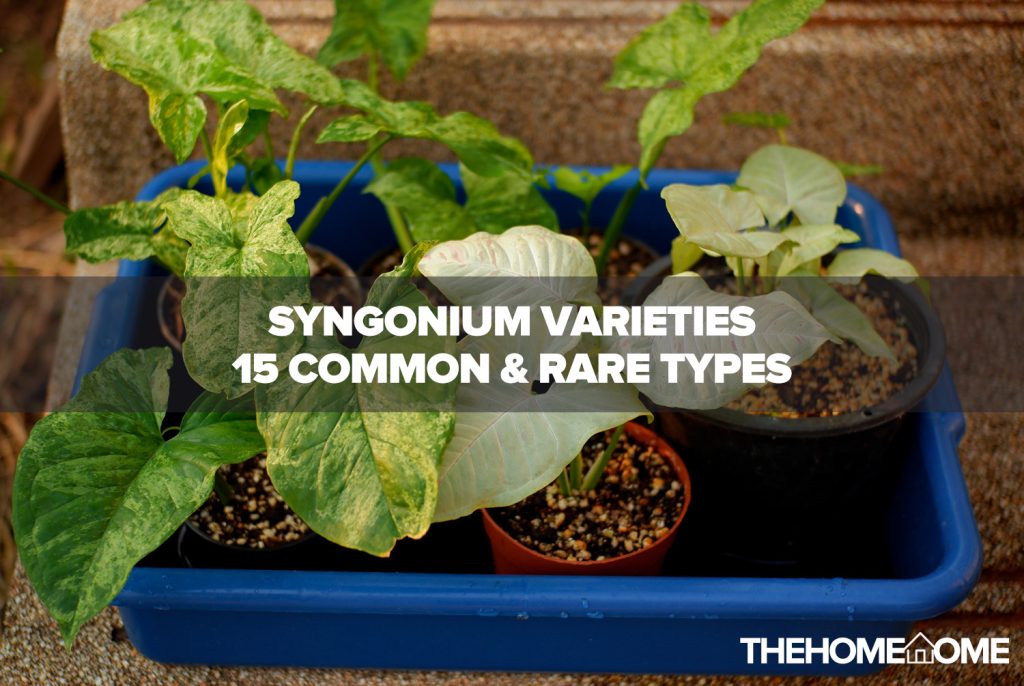The Syngonium houseplant is popular for its diverse foliage shape, design, and color. The plants come in wide and arrow-shaped leaves with a variety of foliage designs. Its prominent colors are green and white. Some varieties have pink as their foliage color, especially the rare Synognium types.
All varieties of the Syngonium species are striking plants that can do wonders as an aesthetic addition to your home.
The Syngonium plant can be grown both indoors and outdoors. They are accented by using brightly colored containers and creative hangers for placement.
The Syngonium plant is an affordable, easy-to-propagate, and low-maintenance plant that would survive in harsh conditions longer than other houseplants. They are sure to thrive when provided with moderate watering, proper lighting, appropriate soil mix, well-drilled containers, and appropriate temperate conditions.
We have provided 15 of the most attractive Syngonium varieties in case you are on the lookout for a houseplant to propagate. Amongst these varieties, you would find interesting options with varied foliage colors and shapes.
Arrowhead Plant Basic Information And Care Guide
This is a profile of the Syngonium plant alongside some care tips that would come in handy during your propagation and nurturing journey.
| Botanical name | Syngonium spp. |
| Light | Bright indirect light |
| Watering | Moderate watering |
| Temperature | 60°F-80°F |
| Toxicity | Toxic to pets and humans |
| Food | Balanced house plant fertilizer |
| Humidity | Low humidity |
| Foliage color | Green, Cream, White, and Pink |
| Susceptible Plant Issues | Root rot, Wilting leaves, Sparse growth, Yellow/ Brown / Dried Leaves, Pest Infestations |
Adopt these tips and have a hitch-free Syngonium propagation.
- Make use of drilled holes to prevent your Syngonium plant from being swamped by water.
- Regularly spray your plant to mist the leaves and to wade off pests; if misting the leaves does not improve the humidity level, make use of humidifiers.
- Do not use any fertilizer without reading the precautions and recommendations.
- During winter, move your Syngonium plant indoors if grown outdoors during winter.
- Ensure the plant is placed in a bright area.
- After the delivery of an online order, allow your Syngonium plant to adjust to the environment before transplanting it to reduce the effect of a transplant shock on the plant.
- Avoid using aluminum containers to pot your Syngonium plants, they emit elements that can damage the soil.
- Keep your Syngonium plant out of the reach of kids and pets as they are highly toxic.
- Frequently lookout for a change in foliage color and appearance as they could be signals to a plant problem that has occurred.
- Ensure the soil is never completely dried out before watering.
15 Common & Rare Syngonium Varieties You Can Grow Today (With Pictures)
Out of these 15 most popular and attractive Syngonium varieties, look out for the most captivating species and add it to your to-propagate list.
1. Syngonium Pink allusion
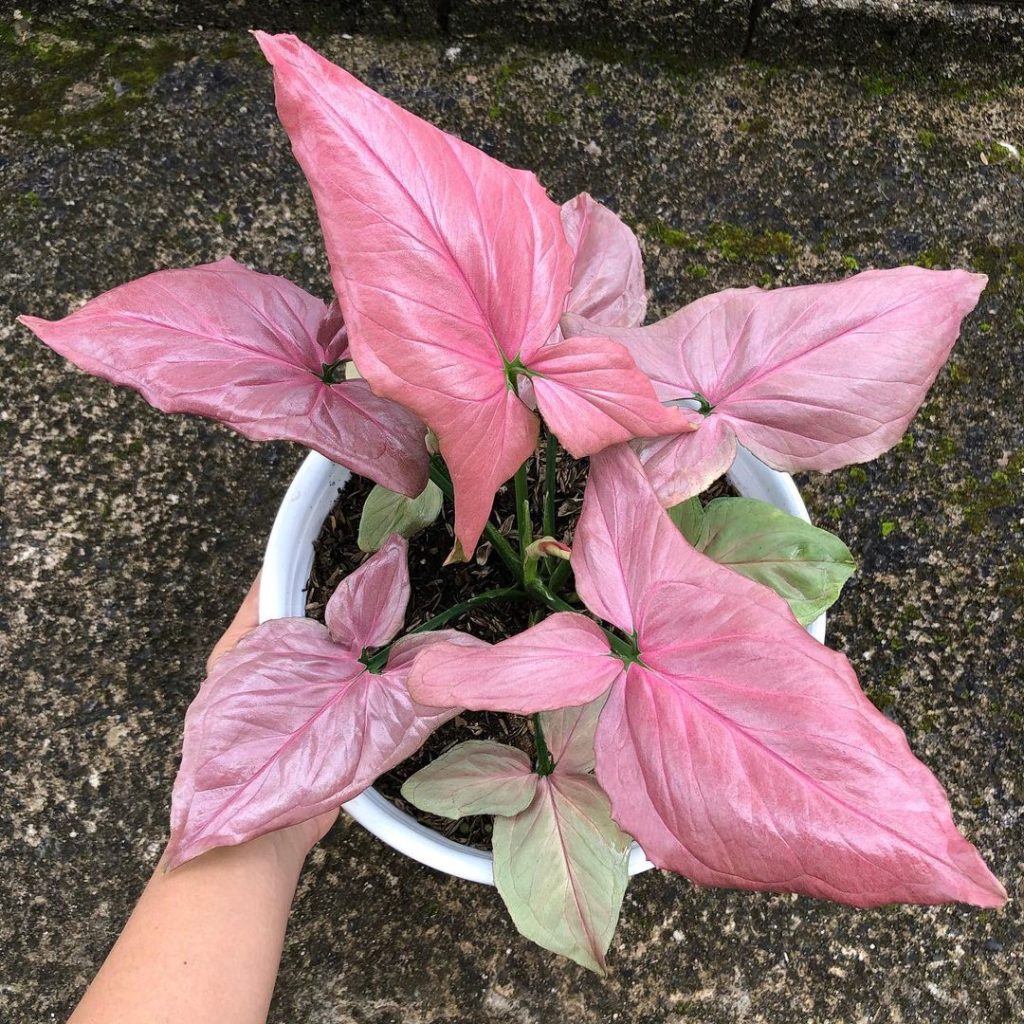
The pale pink leaves of this Syngonium plant contribute to its feature as a striking plant. Most Syngonium plants are wide in foliage size, but the attractiveness of this variety is unmatched because of its distinct foliage color. Some species of this variety are pink while others have streaks of green on the plants.
Other varieties have dotted pink markings as their foliage design. The Syngonium Pink allusion has its origin in Tropical Central and South America. This variety can be grown as both a standard houseplant and a trailing plant. In addition to this, they can be grown indoors and outdoors.
If grown indoors, they can be grown in your living room or balcony, although the choice is subject to your fancy.
The Pink Allusion variety would thrive when its growth needs are adequately catered for. These needs are adequate watering, proper lighting, organic soil, appropriate temperate, and suitable containers that match the size of the plant. Guess what? This variety can pass for a housewarming gift.
2. Syngonium White Butterfly
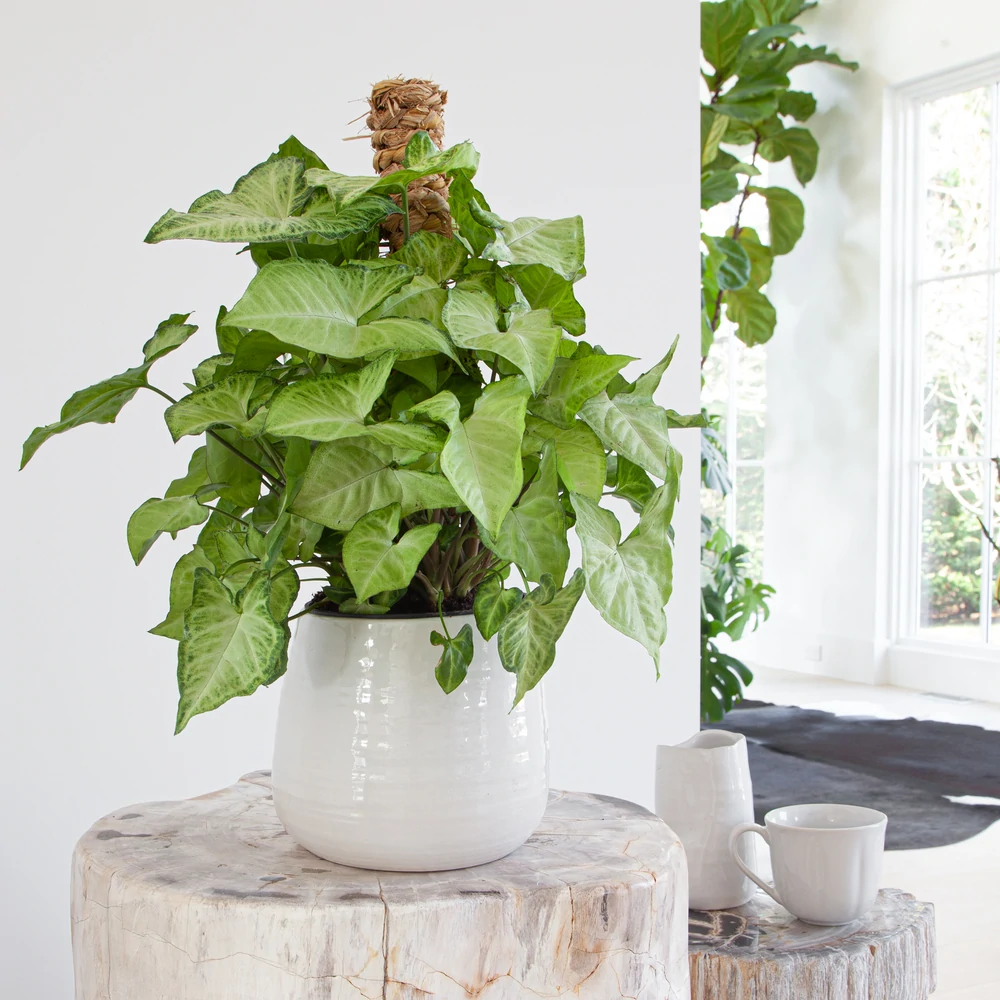
As the name suggests, the Syngonium White butterfly’s foliage design has a semblance to a butterfly’s shape. This unique variety can light any location in your home whether indoors or outdoors. The White Butterfly is a popular houseplant that can be purchased from nearby nurseries or online stores.
After making an order from an online store, ensure proper attention is given to your plant as that stage determines the survival of your plant. Ensure the plant is properly watered, receives medium lighting, and is kept away from drafts. In addition, do not fertilize till the plant is mature.
To get the maximum height of this plant, include a support stake made from natural material and watch your Syngonium butterfly attain new heights. While tending to these plants, wear gloves to prevent contact with the plant’s sap.
Both the plant’s sap and the plant itself are highly toxic to humans and pets, so they should be kept out of the reach of your kids and pets.
3. Syngonium Aurea Variegata
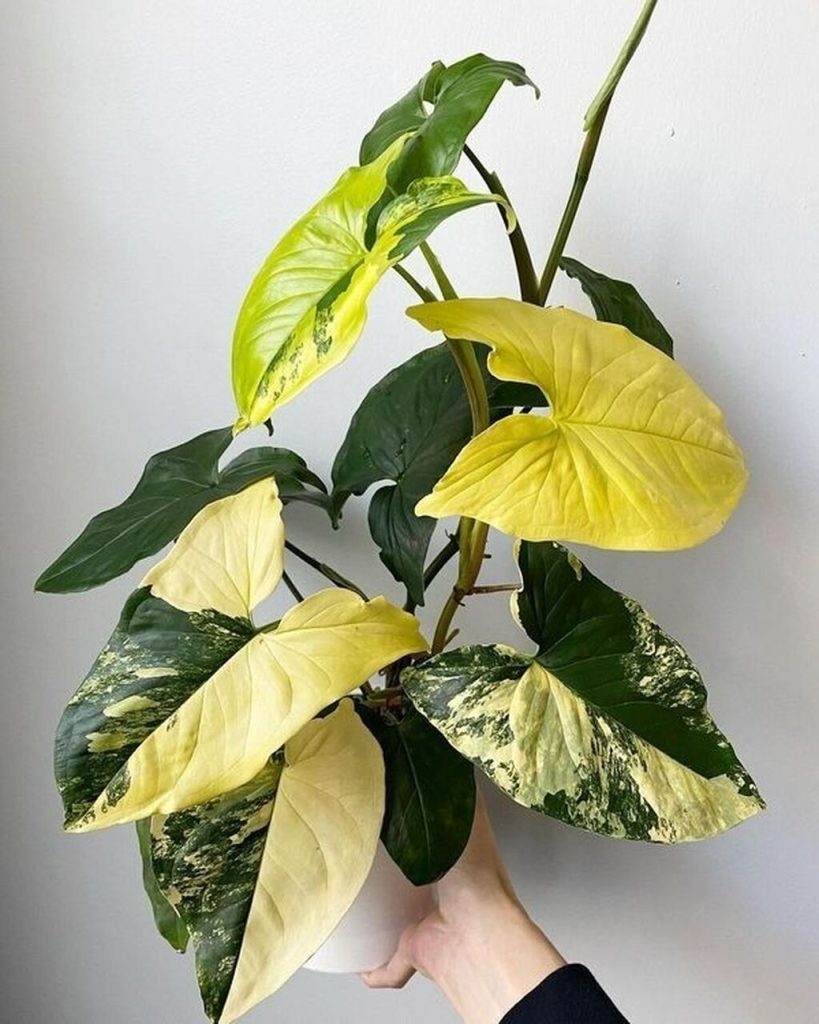
Syngonium Aurea Variegata is another sticking variety of Syngonium. The leaves are patterned with yellow variegated colors that make them stand out and it happens to be one of the most sought-after variants.
This variety of Syngonium prefers moist soil to dry out between waterings and it is best to use a water calculator to gauge its water needs.
Aurea Variegated is not a difficult plant to care for, it simply needs to be placed in the right spot and watered in small amounts several times. These lovely plants will vine if given the opportunity.
This is a really special variety of Syngonium and it is rare as well. As the leaves of aurea Variegata unfurl, it becomes light green while it is specifically characterized by their beautiful yellow-green leaves.
4. Syngonium Albolineatum
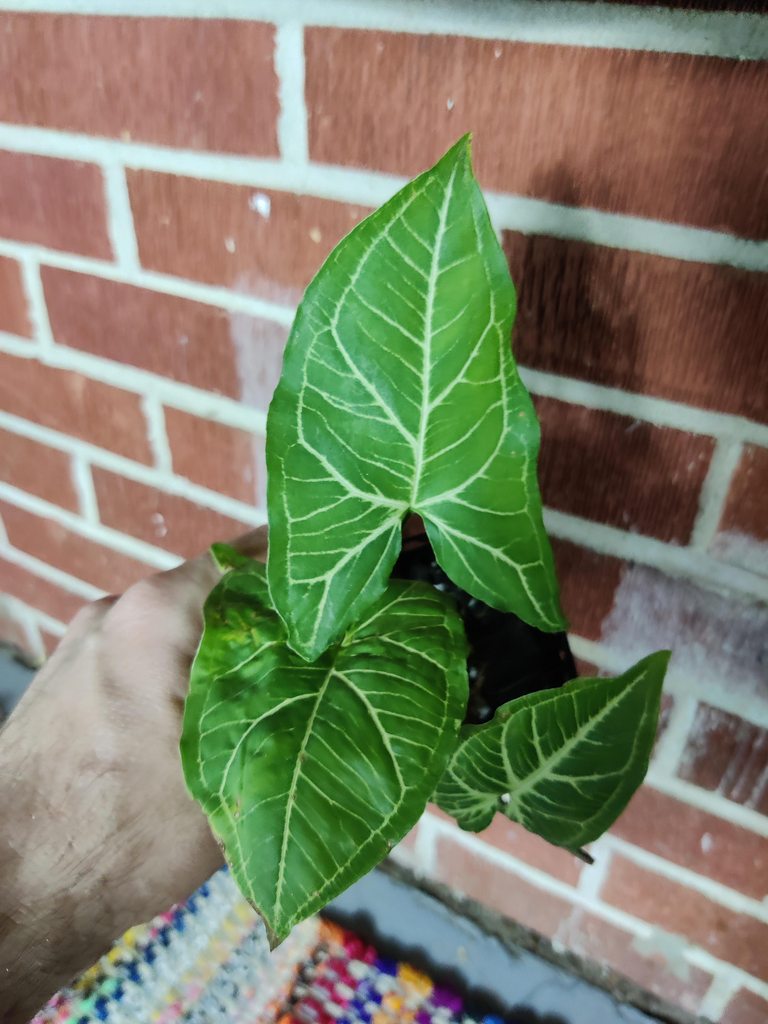
This variety belongs to the class of uniquely shaped Syngonium. The unusual foliage design of this variety easily captivates onlookers. Syngonium Albolineatum is commonly sold under the tag name “Arrow Head plant”. The prominent color of this variety is dark green with streaks of lighter hues of green and white.
They are inexpensive, easy-to-propagate, and low-maintenance plants. This variety is a good choice if you are just starting as a houseplant grower.
The Arrow Head plant should be placed in a location where it can receive sufficient lighting that would reach all parts of the plant because the wide leaves of this plant can deprive some parts of the plant of receiving adequate lighting.
At intervals, you can rotate the pot or container, so all parts of the plant receive bright light. If grown indoors, you can take them out to receive at least 5-6 hours of bright indirect sunlight especially when the lighting indoors is insufficient.
You can detect poor lighting from the foliage color and vigor of the plant. One of the prominent signs of poor lighting is drooping leaves and faded color.
5. Syngonium Mini Pixie
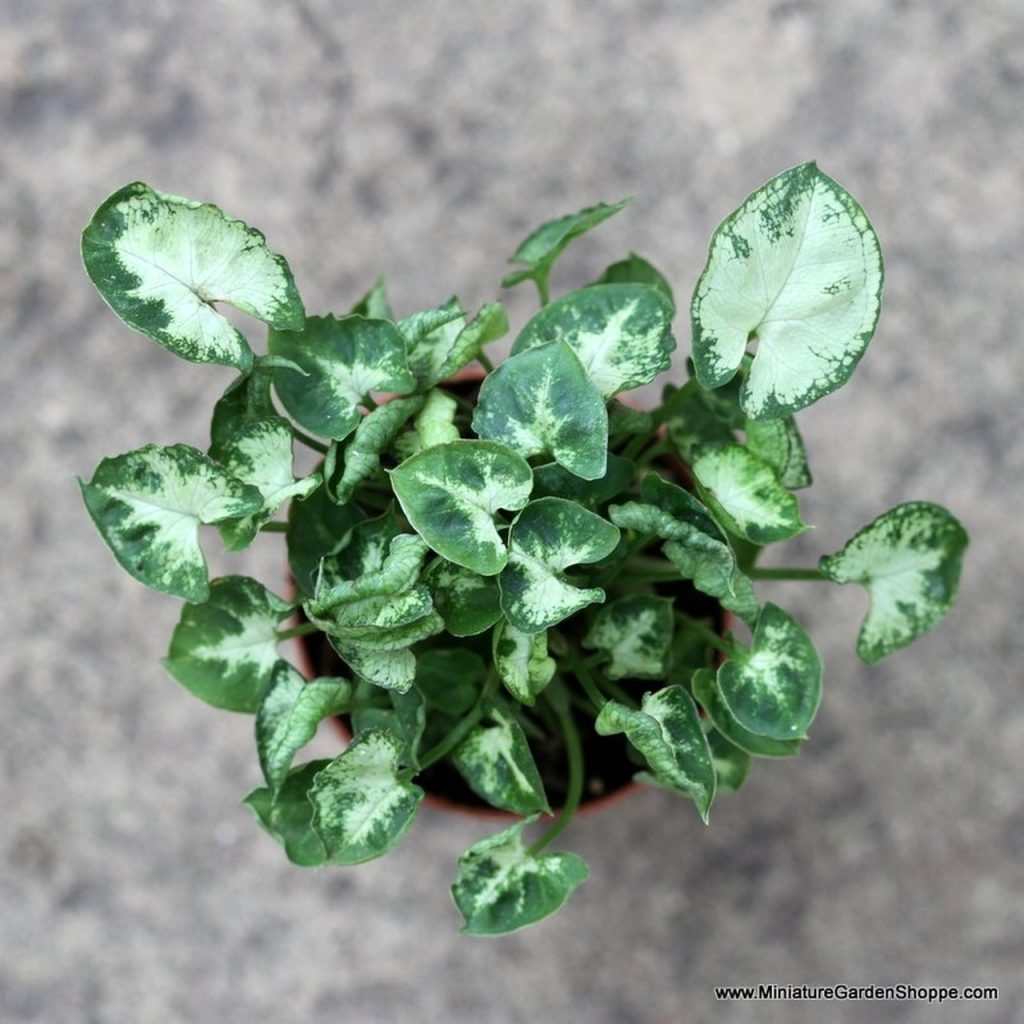
Amongst other varieties, the Syngonium Mini pixie variety has the smallest foliage size. This variety has unique markings of different hues of green. It is also referred to as the Dwarf Arrow Head Plant. The stunning variety is a perfect choice for living rooms and workspaces. Unlike other varieties, this plant does not require trimming because of its compact size.
The Dwarf Arrow Head Plant thrives in temperatures between 60 °F-80 °F and can grow up to 8 inches in height and 3 inches in width when properly tended to. Your Syngonium mini pixie should be provided a moist soil, an appropriate container, moderate lighting, and adequate watering.
Misting the leaves regularly would improve the humidity for Mini pixie houseplants.
Complement the attractiveness of this plant by placing them in brightly colored containers. Positioning them in inconspicuous locations and drab containers tones down their aesthetic effect on your home.
Placing them on hanging shelves would enhance their beautifying effect on your home but ensure they are within the reach of bright indirect sunlight.
6. Syngonium Emerald Gem
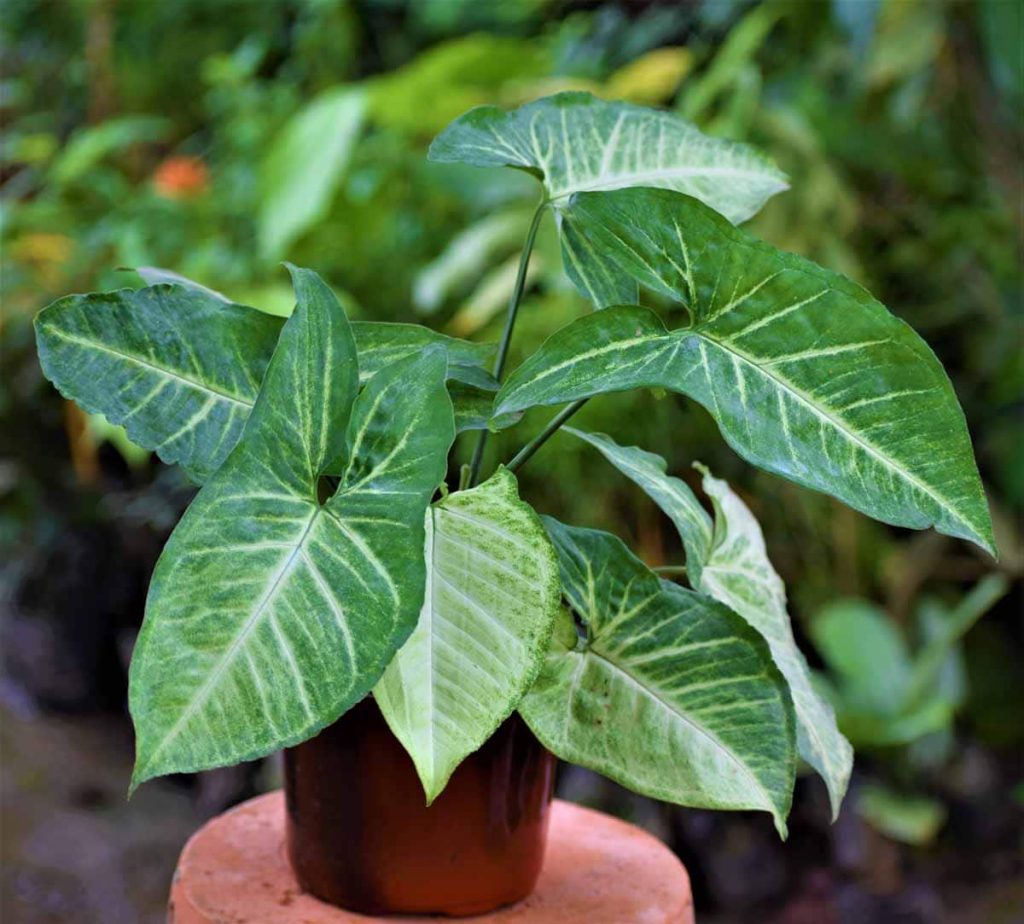
The Syngonium Emerald gem is commonly sold under the tag names “African Evergreen”, and “Arrow Head vine”. What attracts onlookers is the irregular white or cream markings that appear on a portion of the plant. The bloom time for this variety is during late winter and early spring.
The Syngonium Emerald gem is sure to add pops of color to your home whether grown indoors or outdoors especially when they are placed in brightly colored environments.
This variety would survive if its growth needs are provided with inadequate and appropriate measures. Their soil must always be moist; adequate watering keeps your soil moist and not soggy which is caused by overwatering. You are expected to water your Syngonium Emerald gem once a week.
Ensure the soil never dries out before watering. In addition, this plant should be positioned in an area where it can receive bright indirect sunlight. If they are grown outdoors, ensure they are grown in shaded areas to avoid exposure to scorching heat from the sun.
7. Syngonium Confetti
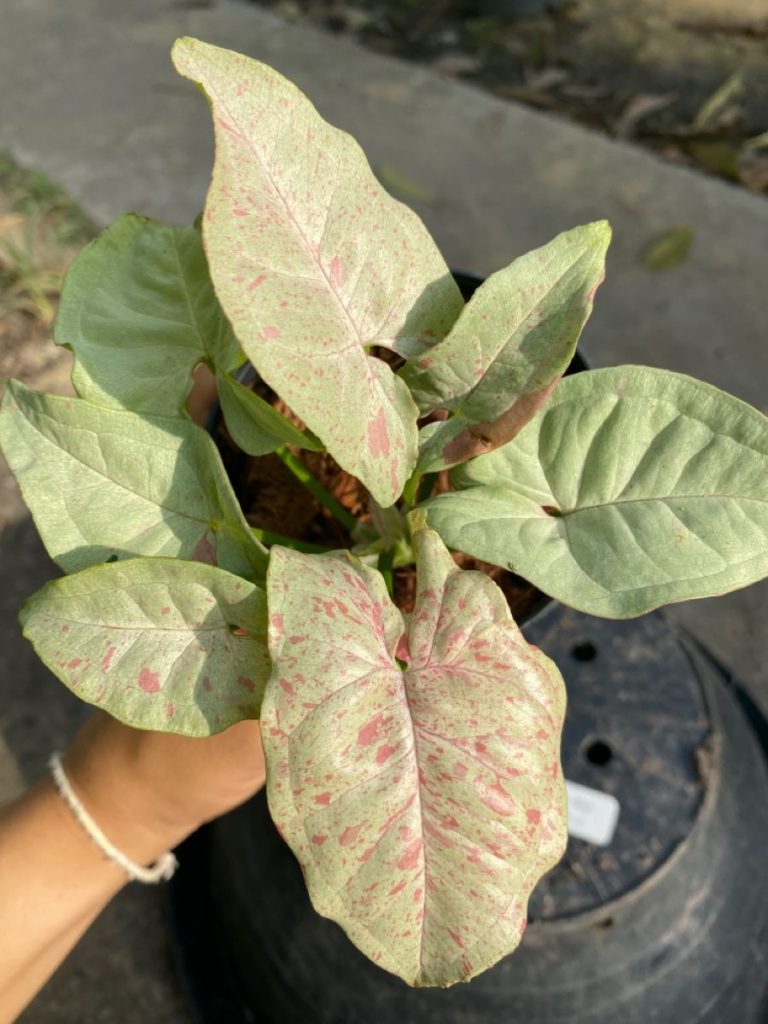
Syngonium confetti is also known as ‘Milk Confetti’ and it’s a really gorgeous plant. This plant is quite rare and it features arrow-shaped leaves marbled paired with shades of green and pink patches. It’s a show-stopping plant and depending on the age of the plant, it can change shape dynamically from arrow-shaped to lobes resembling irregular stars with an elongated beam.
This variety of Syngonium prefers bright indirect light. It happens to type a rare collection with its finely streaked dark green veins. This plant is low-light tolerant but it will grow really fast while also maintaining its striking features.
Allow it to dry out partially before watering. It should be allowed to stay evenly moist but not wet.
8. Syngonium Wedlandii
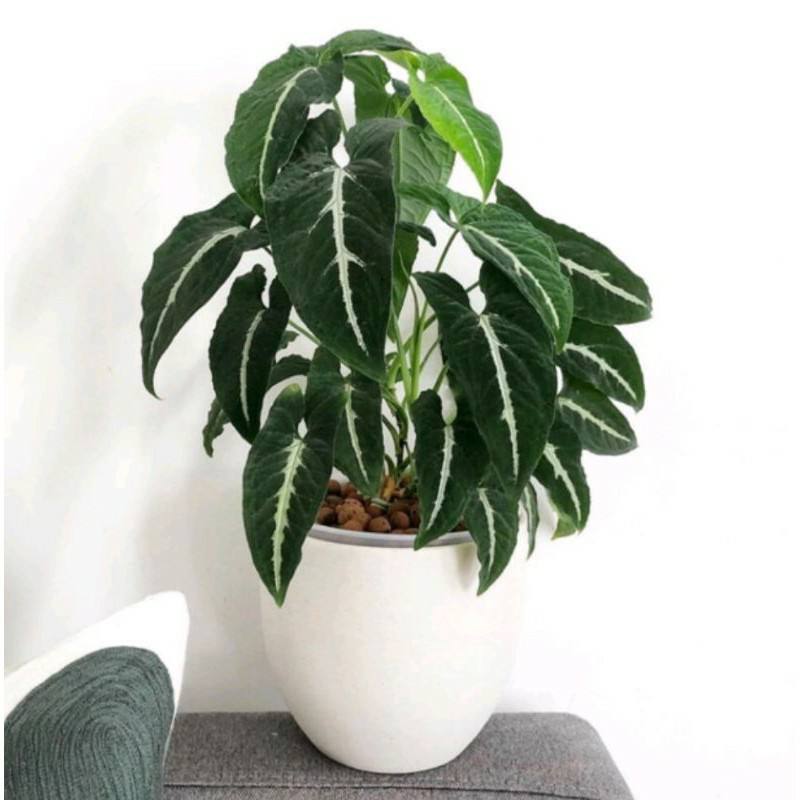
This variety is differentiated from other Syngonium plants by the white-lined markings at the center of the plant. The brightly colored white line demarcates the plant into equal halves and this is why the Syngonium Wedlandii is a stunning plant. This plant is suitable for indoor and outdoor propagation.
When properly tended to, the Syngonium plant can grow up to 1.5 m in height. It has its origin in America and Mexico. During winter, let there be a reduction in providing some growth needs such as watering and fertilizer.
The plant should be kept out of the reach of kids and pets because they are highly toxic. When tending to this plant, ensure you check the soil texture before watering to gauge the amount of water the plant requires. In addition, look out for pest infestations that can affect the growth of plants.
They are mostly affected by mealybugs, spider mites, and Aphids especially when they are grown outdoors. Ensure that you have separate pruning equipment other than the ones used for plants grown outdoors.
9. Syngonium Silver Pearl
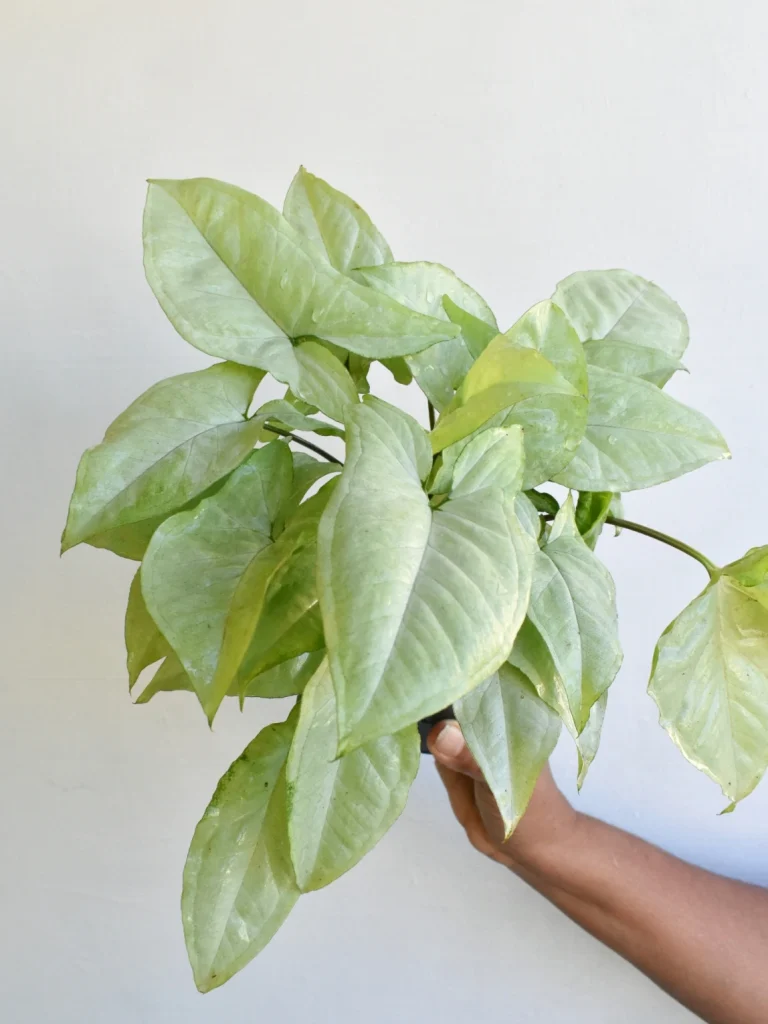
This plant is one of the popular Syngonium varieties and it is known as the American evergreen and Arrowhead.
This is one of the easiest houseplants to care for, it is a genus of flowering plants belonging to the Araceae family. It can also be referred to as Gooseplant which seems to indicate that it is a simple but elegant plant.
Syngonium silver pearl is also a very versatile houseplant. It is a compact plant that is white and somewhat green which is of a muted hue. However, it is pretty thick compared to other representatives of the Syngonium plants.
10. Syngonium Angustattum
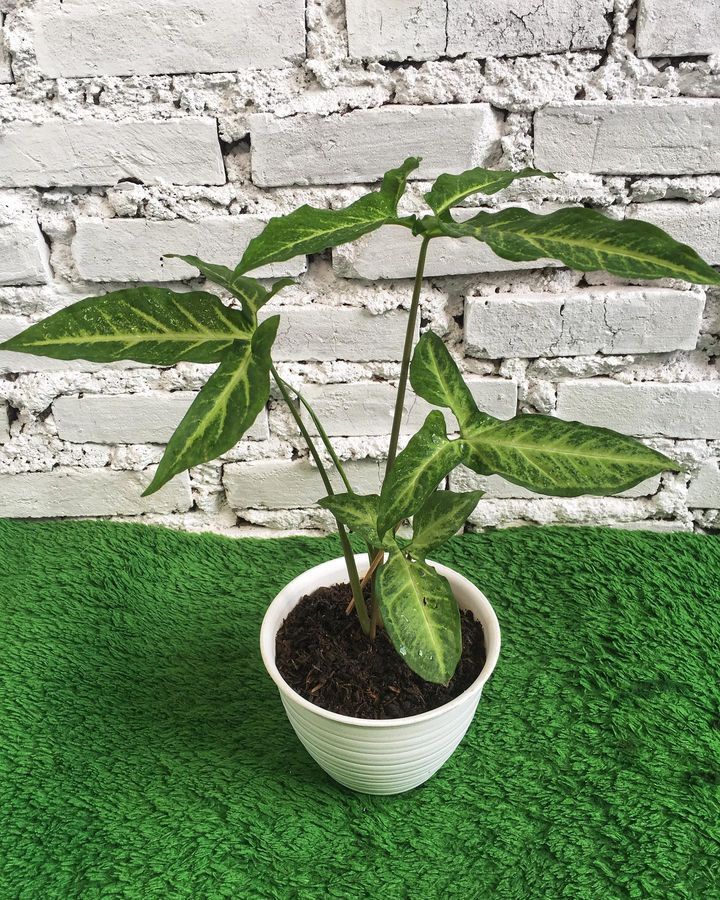
It is commonly referred to as the Five fingers. This is the most unusually shaped Syngonium plant. One single node produces 5 singular plants. The dominant color of this variety is green. They would thrive when placed in brightly lit environments. Ensure they receive about 5-6 hours of sunlight daily.
They thrive in temperatures between 65F-75F and when moderately watered, with medium lighting, organic soil, appropriate temperature, and a suitable container. The best time to fertilize your Five Fingers is during spring and summer. Bright indirect sunlight is the most appropriate kind of lighting needed for this variety.
Ensure the plant is grown in a container that matches the size of the plant. The Five Fingers plant is an easy to propagate and low maintenance plant. They are good options if you have a busy schedule as they require basic growth requirements to survive.
Their pots must be well drilled to allow good drainage of water; this helps prevent waterlogged soil that could lead to root rot.
11. Syngonium Erythrophyllum
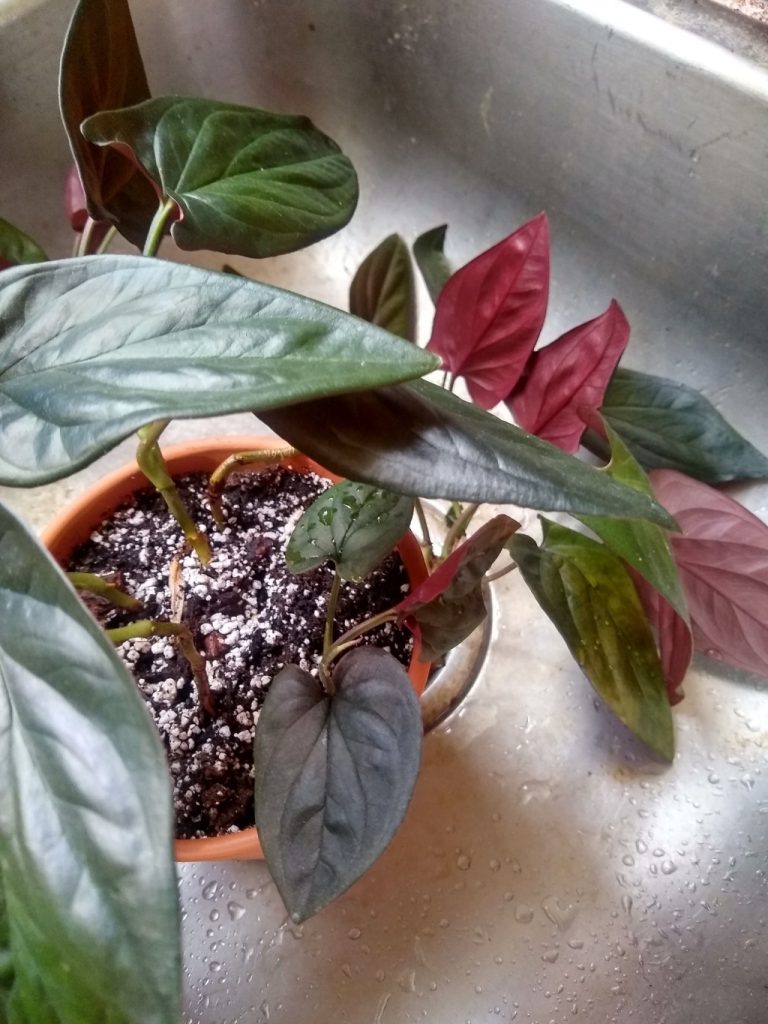
It is commonly sold under the tag name “Red Arrow Plant”. This plant came into being as a result of its dark burgundy color. For some varieties, the burgundy color appears on just one plant out of the bunch while for others, the only color on the plant is burgundy.
The Red Arrow Head plant can be grown as standard houseplants as a crawling plant.
You can enhance their outlook in your home by placing them in dangle baskets and hanging shelves. Wherever they are placed, ensure the plant receives bright light because when they are placed in dangle baskets or hanging shelves, they may be out of the reach of sufficient lighting.
Mist their leaves regularly to improve humidity or make use of humidifiers. Ensure they are grown in warm temperatures. During winter, if grown outdoors, move them indoors. In addition, stay off fertilizing the plant because their roots are usually tender during extreme weather conditions.
After propagating the plant, never allow the soil to completely dry out before watering your Red Arrow Plant.
12. Syngonium Trileaf Wonder
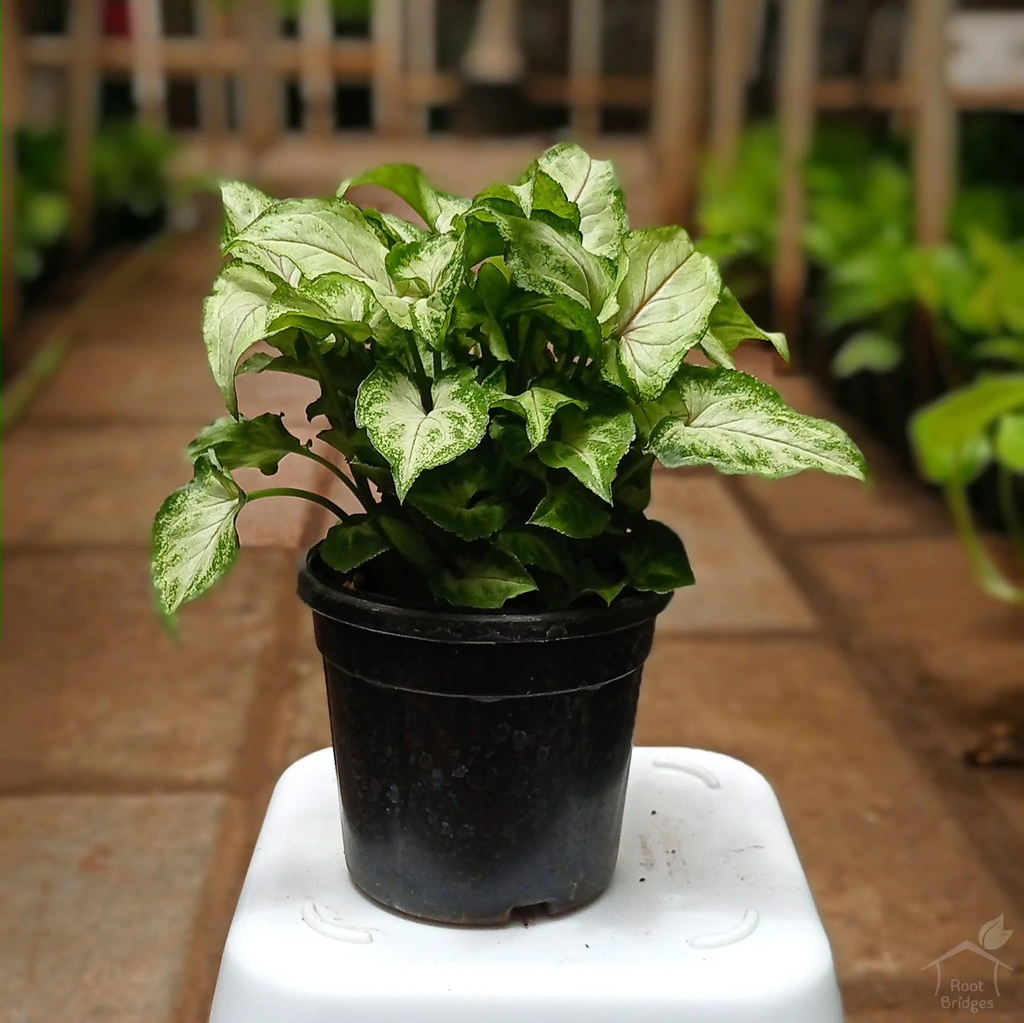
Here is another super houseplant that is not just stunning but easy to propagate and grow. Syngonium trileaf wonder needs regular watering for it to thrive and it does best in moderating light as well.
This variety looks great grown alone but will also do great planted alongside other stunning houseplants.
Trileaf wonder is easy to care for and regarded as the perfect plant for adding jungle style to any space or garden. It can grow up to 6 feet near a window and you can have it trimmed regularly to maintain its height and note that it is a great climber.
This plant has an unusual leaf variety, it starts as light green and can develop into deep glossy green as it matures. It should be placed in indirect sun or shade and a moderate water schedule should be adopted for it.
13. Syngonium Tricolor
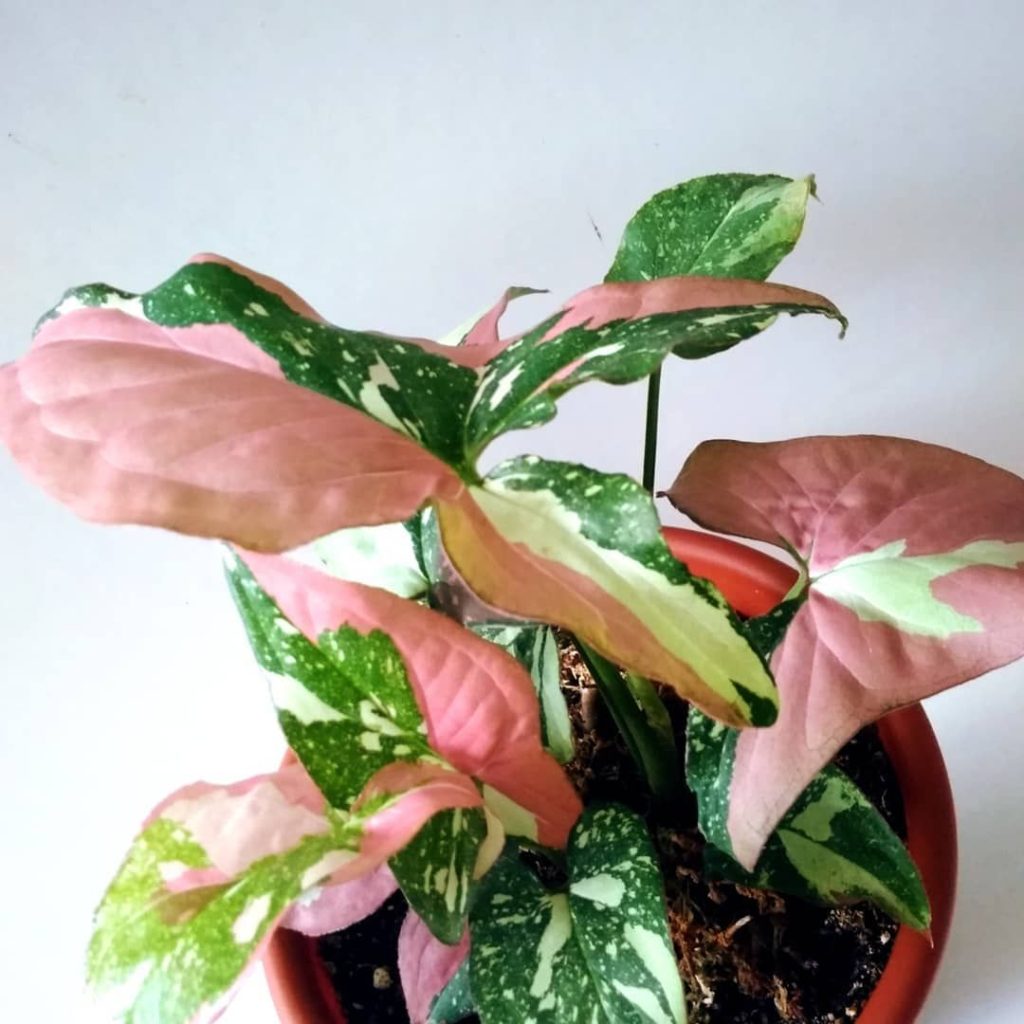
As the name suggests, this Syngonium has three different colors- green, pink, and cream/white. Although the dominant color of this variety is green, it has splotches and speckles of lighter hues of green, white, and pink. This houseplant is an eye-catcher regardless of the location it is placed in your home.
They are relatively affordable houseplants, although they are rare to find in some locations so may have to order online. Allow the plant to adjust to the temperature of your home before applying fertilizers or transplanting to reduce the effect of an environmental shock.
To enhance their growth, young Syngonium Tricolor plants should be supported with a climbing stick made of Sphagnum moss.
This stunning plant would be well appreciated when placed in uniquely sculptured containers. You can propagate other Syngonium varieties if you want a full blast of colors in your home.
The Syngonium Tricolor when it is properly tended to. Their growth needs are watering, organic soil, appropriate temperate conditions, and a well-drilled container. This plant should be kept away from drafts.
14. Syngonium Batik
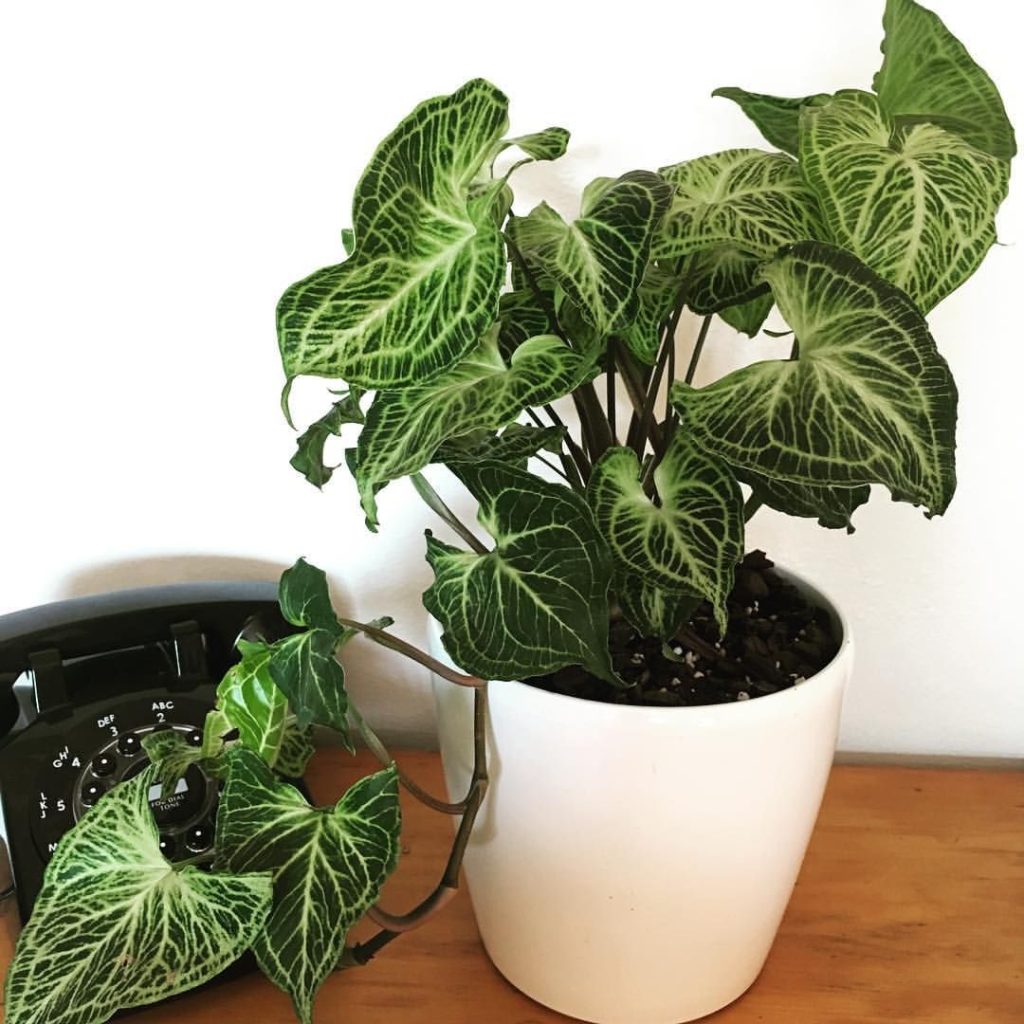
The webbed foliage design of this Syngonium variety makes it one of the most attractive varieties. The dominant color of the Syngonium Batik is green with streaked white lines. For some species, the streaked lines may be lighter green shades.
Since they are sought for their unique foliage design, they are more expensive than other Syngonium varieties.
They thrive in shaded areas where they can receive bright but indirect sunlight from the sun. Most growers prefer having a bushy mass of Syngonium Batik plants. If you are among this lot, regularly snip pups to enhance their growth. Pruning also boosts the growth of the Syngonium batik plants.
While tending and pruning your plant, ensure you wear a glove to prevent contact with the plant’s sap. This variety is a low maintenance plant which makes them suitable for beginner houseplant growers.
15. Syngonium Green Gold Allusion
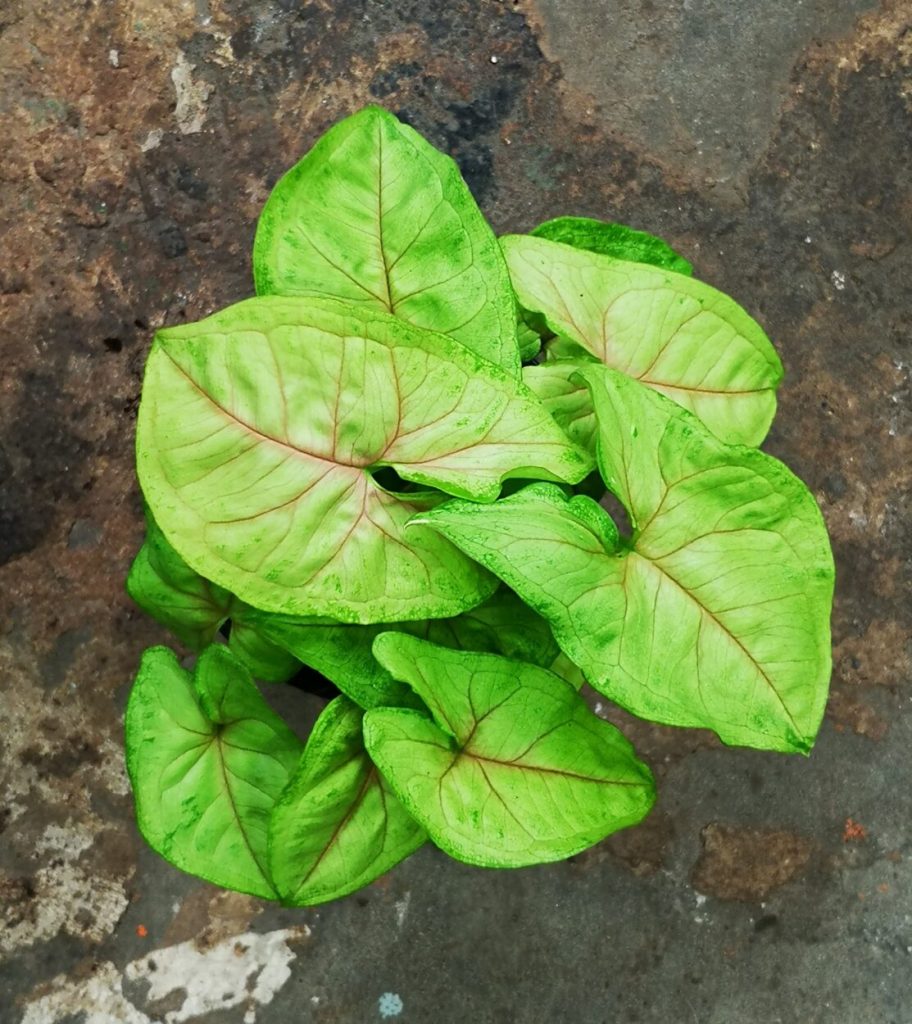
Green Gold Allusion is a specie of Syngonium you can’t help but find quite interesting and stunning.
It is known by names like five fingers, American evergreen, and arrowhead plant. This variety also takes a resemblance to English Ivy due to its waxy shiny leaves but they are very different. It has variegated triangular leaves and as it ages, it begins to vine.
Green Syngonium will tolerate low light settings while it thrives in bright indirect light. This plant features dark green leaves with tinges of pink and gold. It tends to look great as a trailing plant and regular pruning has to be done.
This plant is classed as a tropical plant so wait for the water to drain through before you water it again. It is also very similar to Wedlandii Syngonium hence they do make beautiful combos.
Frequently Asked Questions
How many types of Syngonium are there?
It is hard to work with a specified list when it comes to variants of Syngonium. Syngonium in its natural habitat should have about 30 varieties but there are also other species that are native to tropical America and they are believed to be 16. The ones we see most in cultivation as the podophyllum types and they come in so many impressive varieties.
How do I know what Syngonium I have?
You should be able to identify what type of Syngonium you have based on the color and shape of its leaves. However, some varieties are known to change their color and shape with age.
Is Syngonium a lucky plant?
In some countries, Syngonium plants are regarded as lucky plants, and also according Feng-Shui, it is believed to bring good luck, wealth, prosperity, and abundance to your home.
Final Note
Amidst these varieties, we are sure particular species caught your attention but if there are several, not to worry, you can propagate more than one variety at once, although it may be more tedious tending to them, especially during the propagation stage.
For us, the Syngonium Tricolor is the most striking species. Kindly let us know the Syngonium varieties that may soon appear on your to-plant list.
More varieties of your favorite plants:
- Weigela Varieties: 10 Common & Rare Types Of Weigela
- 6 Common & Rare Spider Plant Varieties To Propagate Today
- Mother of Thousands Plant Varieties: Common & Rare Types
- Heuchera Varieties: 10 Common And Rare Types Of Heuchera
- Tradescantia Varieties: 10 Common And Rare Types
- Begonia Varieties: 10 Common & Rare Types Of Begonia
- Dieffenbachia Varieties: 9 Rare And Common Types
- Peperomia Varieties: 12 Types Of Peperomia Plants

